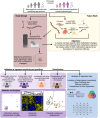DNA methylation signatures for chromatinopathies: current challenges and future applications
- PMID: 37022461
- PMCID: PMC11078831
- DOI: 10.1007/s00439-023-02544-2
DNA methylation signatures for chromatinopathies: current challenges and future applications
Abstract
Pathogenic variants in genes that encode epigenetic regulators are the cause for more than 100 rare neurodevelopmental syndromes also termed "chromatinopathies". DNA methylation signatures, syndrome-specific patterns of DNA methylation alterations, serve as both a research avenue for elucidating disease pathophysiology and a clinical diagnostic tool. The latter is well established, especially for the classification of variants of uncertain significance (VUS). In this perspective, we describe the seminal DNA methylation signature research in chromatinopathies; the complex relationships between genotype, phenotype and DNA methylation, and the future applications of DNA methylation signatures.
© 2023. The Author(s).
Conflict of interest statement
The authors have no conflicts of interest to declare.
Figures

Similar articles
-
Generation of DNA Methylation Signatures and Classification of Variants in Rare Neurodevelopmental Disorders Using EpigenCentral.Curr Protoc. 2022 Nov;2(11):e597. doi: 10.1002/cpz1.597. Curr Protoc. 2022. PMID: 36367395
-
New insights into DNA methylation signatures: SMARCA2 variants in Nicolaides-Baraitser syndrome.BMC Med Genomics. 2019 Jul 9;12(1):105. doi: 10.1186/s12920-019-0555-y. BMC Med Genomics. 2019. PMID: 31288860 Free PMC article.
-
Anatomy of DNA methylation signatures: Emerging insights and applications.Am J Hum Genet. 2021 Aug 5;108(8):1359-1366. doi: 10.1016/j.ajhg.2021.06.015. Epub 2021 Jul 22. Am J Hum Genet. 2021. PMID: 34297908 Free PMC article. Review.
-
Genomic DNA Methylation Signatures Enable Concurrent Diagnosis and Clinical Genetic Variant Classification in Neurodevelopmental Syndromes.Am J Hum Genet. 2018 Jan 4;102(1):156-174. doi: 10.1016/j.ajhg.2017.12.008. Am J Hum Genet. 2018. PMID: 29304373 Free PMC article.
-
The phenomenal epigenome in neurodevelopmental disorders.Hum Mol Genet. 2020 Sep 30;29(R1):R42-R50. doi: 10.1093/hmg/ddaa175. Hum Mol Genet. 2020. PMID: 32766754 Free PMC article. Review.
Cited by
-
Comprehensive EHMT1 variants analysis broadens genotype-phenotype associations and molecular mechanisms in Kleefstra syndrome.Am J Hum Genet. 2024 Aug 8;111(8):1605-1625. doi: 10.1016/j.ajhg.2024.06.008. Epub 2024 Jul 15. Am J Hum Genet. 2024. PMID: 39013458 Free PMC article.
-
Epigene functional diversity: isoform usage, disordered domain content, and variable binding partners.Epigenetics Chromatin. 2025 Feb 1;18(1):8. doi: 10.1186/s13072-025-00571-z. Epigenetics Chromatin. 2025. PMID: 39893491 Free PMC article.
-
Chromatinopathies: insight in clinical aspects and underlying epigenetic changes.J Appl Genet. 2024 May;65(2):287-301. doi: 10.1007/s13353-023-00824-1. Epub 2024 Jan 5. J Appl Genet. 2024. PMID: 38180712 Free PMC article. Review.
-
Episignatures in practice: independent evaluation of published episignatures for the molecular diagnostics of ten neurodevelopmental disorders.Eur J Hum Genet. 2024 Feb;32(2):190-199. doi: 10.1038/s41431-023-01474-x. Epub 2023 Oct 23. Eur J Hum Genet. 2024. PMID: 37872275 Free PMC article.
-
Advancing the Clinical and Molecular Understanding of Cornelia de Lange Syndrome: A Multidisciplinary Pediatric Case Series and Review of the Literature.J Clin Med. 2024 Apr 21;13(8):2423. doi: 10.3390/jcm13082423. J Clin Med. 2024. PMID: 38673696 Free PMC article. Review.
References
-
- Aref-Eshghi E, Rodenhiser DI, Schenkel LC, Lin H, Skinner C, Ainsworth P, Paré G, Hood RL, Bulman DE, Kernohan KD, Boycott KM, Campeau PM, Schwartz C, Sadikovic B. Genomic DNA methylation signatures enable concurrent diagnosis and clinical genetic variant classification in neurodevelopmental syndromes. Am J Hum Genet. 2018;102:156–174. doi: 10.1016/j.ajhg.2017.12.008. - DOI - PMC - PubMed
-
- Awamleh Z, Choufani S, Cytrynbaum C, Alkuraya F, Scherer S, Fernandes S, Rosas C, Louro P, Dias P, Neves M, Sousa S, Weksberg R. ANKRD11 pathogenic variants and 16q243 microdeletions share an altered DNA methylation signature in patients with KBG syndrome. Hum Mol Genet. 2022 doi: 10.1093/hmg/ddac289. - DOI - PMC - PubMed
-
- Awamleh Z, Chater-Diehl E, Choufani S, Wei E, Kianmahd RR, Yu A, Chad L, Costain G, Tan WH, Scherer SW, Arboleda VA, Russell BE, Weksberg R (2022b) DNA methylation signature associated with Bohring-Opitz syndrome: a new tool for functional classification of variants in ASXL genes. Eur J Hum Genet 30(6):695–702. 10.1038/s41431-022-01083-0 - PMC - PubMed
-
- Biesecker LG, Adam MP, Alkuraya FS, Amemiya AR, Bamshad MJ, Beck AE, Bennett JT, Bird LM, Carey JC, Chung B, Clark RD, Cox TC, Curry C, Dinulos MBP, Dobyns WB, Giampietro PF, Girisha KM, Glass IA, Graham JM, Jr, Gripp KW, Haldeman-Englert CR, Hall BD, Innes AM, Kalish JM, Keppler-Noreuil KM, Kosaki K, Kozel BA, Mirzaa GM, Mulvihill JJ, Nowaczyk MJM, Pagon RA, Retterer K, Rope AF, Sanchez-Lara PA, Seaver LH, Shieh JT, Slavotinek AM, Sobering AK, Stevens CA, Stevenson DA, Tan TY, Tan WH, Tsai AC, Weaver DD, Williams MS, Zackai E, Zarate YA. A dyadic approach to the delineation of diagnostic entities in clinical genomics. Am J Hum Genet. 2021;108:8–15. doi: 10.1016/j.ajhg.2020.11.013. - DOI - PMC - PubMed
-
- Butcher DT, Cytrynbaum C, Turinsky AL, Siu MT, Inbar-Feigenberg M, Mendoza-Londono R, Chitayat D, Walker S, Machado J, Caluseriu O, Dupuis L, Grafodatskaya D, Reardon W, Gilbert-Dussardier B, Verloes A, Bilan F, Milunsky JM, Basran R, Papsin B, Stockley TL, Scherer SW, Choufani S, Brudno M, Weksberg R. CHARGE and Kabuki syndromes: gene-specific DNA methylation signatures identify epigenetic mechanisms linking these clinically overlapping conditions. Am J Hum Genet. 2017;100:773–788. doi: 10.1016/j.ajhg.2017.04.004. - DOI - PMC - PubMed
Publication types
MeSH terms
Substances
LinkOut - more resources
Full Text Sources

